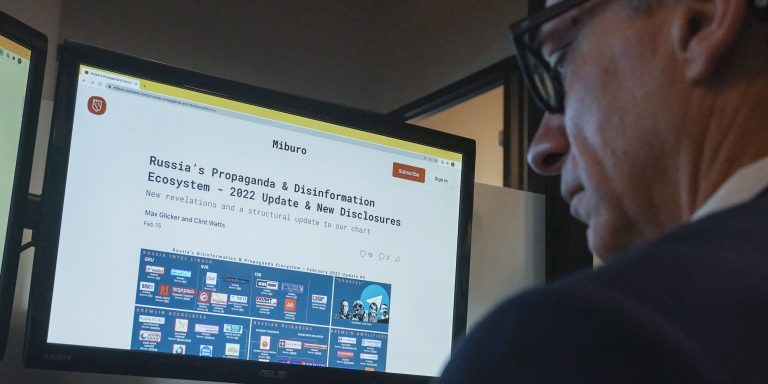
Disinformation will continue to evolve in 2023 with several trends worth highlighting, including: Sino-Russian alignment, more state actors seeking to acquire sophisticated disinformation capabilities, and the harnessing of emerging technologies for information manipulation purposes.
Telegram has emerged as one of the primary platforms used to spread disinformation to myriad online audiences.
Seeming Sino-Russian alignment in the information manipulation space has geopolitical implications for 2023, given the “no limits” partnership between Beijing and Moscow announced on the sidelines of the 2022 Winter Olympics.
While Russia, China, and Iran continue to be assessed as the most capable disinformation actors, other states have been seeking to acquire more sophisticated capabilities in recent years.
In 2022, disinformation—the deliberate dissemination of false or misleading information—poses an ongoing security risk to governments, societies, the private sector, and non-governmental organizations (NGOs). While a myriad of state and non-state actors utilize disinformation for various goals, the state actors most capable of leveraging disinformation campaigns as a foreign policy tool are Russia, China, and Iran. Just as state-backed/aligned disinformation campaigns in 2020 were dominated by COVID-19 pandemic-related topics, the 2022 “disinformation year” can largely be defined by Russia’s illegal war in Ukraine. Inevitably, disinformation will continue to evolve in 2023 and beyond, with several trends worth highlighting, including: Sino-Russian alignment, more state actors seeking to acquire sophisticated disinformation capabilities, and the harnessing of emerging technologies for information manipulation purposes.
Narratives about Russia’s illegal invasion of Ukraine have dominated the disinformation space in 2022. State-backed and aligned actors have attempted to justify the conflict through disinformation, redirecting blame onto the United States specifically, and the West and NATO more broadly, in an attempt to undermine support for Ukraine. This includes Russian state-seeded disinformation narratives directly connected to the war, including the false claims of Russia’s illegal war being launched to “de-Nazify” Ukraine. It also includes tangential disinformation narratives targeting the United States, NATO, and the EU—including falsities aimed to influence opinion about Sweden and Finland’s NATO bid, conspiracy theories placing unsubstantiated blame on the United States for the Nord Stream 1 and 2 sabotage attacks, and disinformation narratives about the responsible parties for the energy crisis in Europe and the global food crisis. While Russia-backed/aligned disinformation networks have utilized traditional social media platforms like Facebook, to peddle these types of narratives, Telegram has emerged as one of the primary platforms used to spread disinformation to myriad online audiences.
2022 has also illustrated Sino-Russian alignment and amplification of disinformation narratives. Of note, the CCP’s primary information manipulation focus in 2022 has been related to domestic or regional issues, such as external and internal messaging on the COVID-19 situation in China, international attention on human rights abuses in Xinjiang (especially in relation to the 2022 Winter Olympics in Beijing), and issues related to Cross-Strait relations. Still, there has been evidence of CCP-backed/aligned actors amplifying and aligning with Kremlin-backed disinformation narratives. While this trend emerged in 2020, for example peddling falsities about the origins of COVID-19, it has been further crystalized in 2022—especially focused on denigrating the West. The Chinese Communist Party (CCP) has amplified Kremlin-seeded disinformation campaigns about Ukraine with the goal of denigrating the United States, NATO, and the West. For example, CCP officials and CCP-backed/aligned online networks have amplified false claims about secret biolabs in Ukraine, blamed the United States for the global food crisis, and insinuated that the U.S. is responsible for the Nord Stream 1 and 2 sabotage. Seeming Sino-Russian alignment in the information manipulation space has geopolitical implications for 2023, given the “no limits” partnership between Beijing and Moscow announced on the sidelines of the 2022 Winter Olympics.
While Russia, China, and Iran continue to be assessed as the most capable disinformation actors, other states have been seeking to acquire more sophisticated capabilities in recent years. In July 2022, Twitter’s former head of security filed a whistleblower complaint to the Securities and Exchange Commission and the Federal Trade Commission, in which he stated that—apart from Russia—he believes that the governments of India and Nigeria tried to influence the platform through having full-time employees hired who would potentially spy on users. This follows the high-profile case unveiled in 2019 of former Twitter employees accused of working on behalf of a Saudi government agent on infiltrating the platform to access information on dissidents—two of them were convicted by a jury in 2022. In 2019, Meta took down a Facebook and Instagram-based network engaging in coordinated inauthentic behavior that originated in the UAE and Egypt. According to Meta’s report, the coordinated inauthentic behavior on Facebook and Instagram primarily targeted online users in other countries in the Middle East as well as North and East Africa. Indeed, as disinformation campaigns can be used as a relatively cheap and possibly effective tool of influence against another government, political dissidents, or to stoke chaos and confusion for political goals it should be expected that more state actors will seek to increase their capability and effectiveness in this arena. Not all state actors will have the goal to target other states or populations outside of their own borders, but as social media becomes a prominent mode of information and communication we could see other state actors attempting to utilize disinformation for political and geopolitical goals.
State-backed/aligned actors will continue to innovate by circumventing policies aimed at curbing the proliferation of disinformation online. For example, in 2022, the European Union banned Russian state-backed media outlets, including Russia Today and Sputnik. In September 2022, Meta announced that they had disrupted a large Russia-backed network on Facebook, which was impersonating European news outlets to spread pro-Kremlin narratives about the war in Ukraine. While this case illustrates a relatively low-tech capability, innovation in the areas of emerging technology can aid faster and more sophisticated disinformation campaigns. For example, sophisticated AI-powered language models, such as OpenAI’s ChatGPT, could be used to generate fake articles, posts, and other text information sources at a much greater speed with a lower probability of error than humans.
